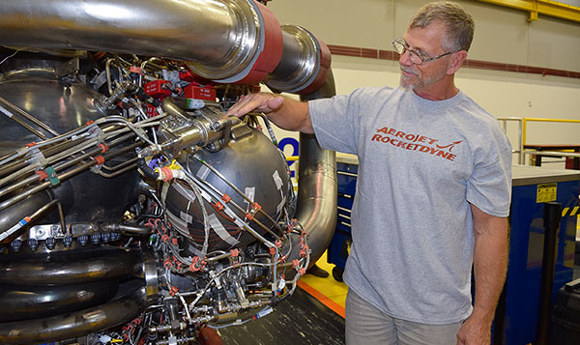NASA completes hot-fire testing of RS-25 rocket engine with metal AM component
December 23, 2017

The pogo accumulator assembly acts as a shock absorber to dampen oscillations caused by propellants as they flow between the vehicle and the engine (Courtesy Aerojet Rocketdyne)
NASA and Aerojet Rocketdyne have completed hot-fire testing of an RS-25 rocket engine containing its largest metal additively manufactured component to date. During a 400-second test at Stennis Space Center, Mississippi, USA, Aerojet Rocketdyne was able to evaluate the performance of its metal additively manufactured vibration damping device, known as a ‘pogo accumulator assembly’. It is hoped that the use of AM to produce aerospace components will help to lower the cost of future missions for NASA’s Space Launch System (SLS) heavy-lift rocket.
The pogo accumulator assembly is a complex piece of hardware consisting of two components – the pogo accumulator and pogo-z baffle – and acts as a shock absorber to dampen oscillations caused by propellants as they flow between the vehicle and the engine. The pogo accumulator assembly is important to ensuring a safe flight by stabilising these potential oscillations.
This test demonstrates the viability of using additive manufacturing to produce even the most complex components in one of the world’s most reliable rocket engines.” – Eileen Drake, CEO and President of Aerojet Rocketdyne
By additively manufacturing both the pogo accumulator and pogo-z baffle using Selective Laser Melting (SLM), Aerojet Rocketdyne reports that it was able to dramatically simplify production, cutting back on the number of pieces to be welded together by 78%. A reduction in the number of welds shortens component development timelines and enables enhanced design flexibility.
Eileen Drake, CEO and President of Aerojet Rocketdyne, stated, “This test demonstrates the viability of using additive manufacturing to produce even the most complex components in one of the world’s most reliable rocket engines. We expect this technology to dramatically lower the cost of access to space.”
The SLS is designed to send astronauts and cargo to explore the moon and other deep space destinations and uses four Aerojet Rocketdyne-built RS-25 engines, produced at the company’s facility in Los Angeles, California.
“As Aerojet Rocketdyne begins to build new RS-25 engines beyond its current inventory of 16 heritage shuttle engines, future RS-25 engines will feature dozens of additively manufactured components,” explained Dan Adamski, RS-25 programme director at Aerojet Rocketdyne. “One of the primary goals of the RS-25 program is to lower the overall cost of the engine while maintaining its reliability and safety margins. Additive Manufacturing is essential to achieving that goal.”
















